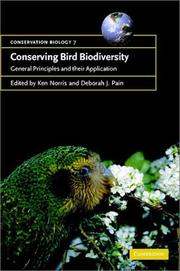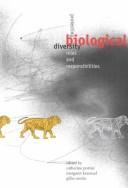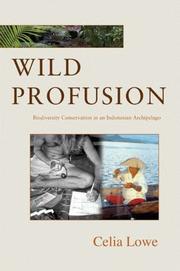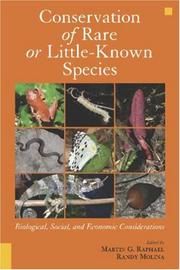| Listing 1 - 10 of 236 | << page >> |
Sort by
|
Book
ISBN: 1783741589 1783741570 1783741597 2821876122 1783741600 Year: 2015 Publisher: Open Book Publishers
Abstract | Keywords | Export | Availability | Bookmark
 Loading...
Loading...Choose an application
- Reference Manager
- EndNote
- RefWorks (Direct export to RefWorks)
This book provides an assessment of the effectiveness of 648 conservation interventions based on summarized scientific evidence. Chapters cover the practical global conservation of amphibians, bats and birds, conservation of European farmland biodiversity and some aspects of enhancing natural pest control, enhancing soil fertility and control of freshwater invasives. It contains key results from the summarized evidence for each conservation intervention and an assessment of the effectiveness of each by international expert panels. The accompanying website www.conservationevidence.com describes each of the studies individually and provides full references.
Biodiversity conservation --- Management. --- Government policy. --- Biodiversity --- Biological diversity conservation --- Conservation of biodiversity --- Diversity conservation, Biological --- Gender mainstreaming in biodiversity conservation --- Maintenance of biological diversity --- Preservation of biological diversity --- Conservation --- Conservation of natural resources --- Ecosystem management --- conservation --- environment protection --- biodiversity --- animals
Book
ISBN: 1789232333 1789232325 183881261X Year: 2018 Publisher: IntechOpen
Abstract | Keywords | Export | Availability | Bookmark
 Loading...
Loading...Choose an application
- Reference Manager
- EndNote
- RefWorks (Direct export to RefWorks)
The present book offers an overall up-to-date overview of the biological diversity, comprising many interesting chapters focussing on the different aspects of biodiversity. Most of the chapters include findings of investigations and observations on biodiversity, whilst a few are based on statistically and theoretically derived information. The book produced sufficient information on the occurrence and distribution of many plant and animal species or groups of organisms with environmental estimates from a wide variety of interesting terrestrial and aquatic habitats. With 18 interesting and elaborately prepared chapters, the present book would definitely be an ideal source of scientific information to the advanced students, junior researchers, scientists and a portion of the public involved in ecology and other research areas involving biodiversity studies. It will also help to the development of the growing awareness of the close linkage between the conversation of biodiversity and economic development.
Biodiversity conservation. --- Biodiversity --- Biological diversity conservation --- Conservation of biodiversity --- Diversity conservation, Biological --- Gender mainstreaming in biodiversity conservation --- Maintenance of biological diversity --- Preservation of biological diversity --- Conservation of natural resources --- Ecosystem management --- Conservation --- Life Sciences --- Ecology --- Environmental Sciences
Book
ISBN: 9535153145 9535107194 Year: 2012 Publisher: IntechOpen
Abstract | Keywords | Export | Availability | Bookmark
 Loading...
Loading...Choose an application
- Reference Manager
- EndNote
- RefWorks (Direct export to RefWorks)
This book "Biodiversity Conservation and Utilization in a Diverse World" sees biodiversity as management and utilization of resources in satisfying human needs in multi-sectional areas including agriculture, forestry, fisheries, wildlife and other exhaustible and inexhaustible resources. Its value is to fulfill actual human preferences and variability of life is measured by amount of genetic variation available. In viewing diversity as an ultimate moral value, one is faced with a situation in environmental preservation in order to allow components of total diversity to flourish and constitute a threat to continuous existence and decrease total diversity. The overall importance described economic benefits from bio-diversity, though difficult to measure and varying, but are limited on a local scale, increase on a regional or national scale and become potentially substantial on a transnational or global scale.
Biodiversity conservation. --- Biodiversity --- Biological diversity conservation --- Conservation of biodiversity --- Diversity conservation, Biological --- Gender mainstreaming in biodiversity conservation --- Maintenance of biological diversity --- Preservation of biological diversity --- Conservation of natural resources --- Ecosystem management --- Conservation

ISBN: 1107120969 1280418044 9786610418046 0511176767 1139146572 051106702X 0511060718 0511606303 0511325592 0511069154 9780511067020 9780511060717 9780521783408 0521783402 9780521789493 0521789494 9780511069154 9780511606304 9781107120969 9781280418044 6610418047 9780511176760 9781139146579 9780511325595 Year: 2002 Publisher: Cambridge, U.K. ; New York : Cambridge University Press,
Abstract | Keywords | Export | Availability | Bookmark
 Loading...
Loading...Choose an application
- Reference Manager
- EndNote
- RefWorks (Direct export to RefWorks)
The earth's biodiversity currently faces an extinction crisis that is unprecedented. Conservationists attempt to intervene in the extinction process either locally by protecting or restoring important species and habitats, or at national and international levels by influencing key policies and promoting debate. Reliable information is the foundation upon which these efforts are based, which places research at the heart of biodiversity conservation. The role of research in such conservation is diverse. It includes understanding why biodiversity is important, defining 'units' of biodiversity, priority-setting for species and sites, managing endangered and declining populations, understanding large-scale processes, making predictions about the future and interfacing with training, education, public awareness and policy initiatives. Using examples from a wide range of bird conservation work worldwide, researchers consider the principles underlying these issues, and illustrate how these principles have been applied to address actual conservation problems for students, practitioners and researchers in conservation biology.
Birds --- Biodiversity conservation. --- Biodiversity --- Biological diversity conservation --- Conservation of biodiversity --- Diversity conservation, Biological --- Gender mainstreaming in biodiversity conservation --- Maintenance of biological diversity --- Preservation of biological diversity --- Conservation of natural resources --- Ecosystem management --- Birds, Protection of --- Conservation. --- Conservation

ISBN: 1282859145 9786612859144 0773569022 9780773569027 0773521585 9780773521582 0773521593 9780773521599 Year: 2001 Publisher: Montreal : McGill-Queen's University Press,
Abstract | Keywords | Export | Availability | Bookmark
 Loading...
Loading...Choose an application
- Reference Manager
- EndNote
- RefWorks (Direct export to RefWorks)
Catherine Potvin, Margaret Kraenzel, and Gilles Seutin asked scientists from developing countries to summarize their experiences of international collaboration and to suggest attitudes and practices that would lead to more fruitful exchanges with northern scientists. They also asked scholars to provide an analytical framework in which these issues could be discussed and to identify possible solutions to questions such as: What are the responsibilities of first world scientists involved in conservation actions in developing countries? How can biologists work toward the protection of biodiversity while being respectful of the human desire for a better future? The resulting papers analyse specific situations encountered in countries such as Democratic Republic of Congo, Madagascar, India, and Panama and discuss the philosophical basis for environmental research. They also examine the work of two institutions whose projects in developing countries have been particularly effective through outreach and attention to local values and needs and who propose a pluralistic view of conservation biology ethics. Protecting Biological Diversity seeks to encourage students and professionals involved in conservation projects to adopt culturally sensitive attitudes that will lead to greater effectiveness and efficiency in conservation and greater respect for the differences of others. Contributors include H Baser (Canadian International Development Agency, Ottawa), P. Butler (Rare Centre for Tropical Conservation, Saint Lucia), R. Cansari (McGill University), A.K. Gupta (Indian Institute of Management, India), M. Martinez-Velarde (Universidad Santa Maria la Antigua, Panama), L. Mubalama (Institut congolais pour la conservation de la nature, Zaire), B.J Norton (School of Public Policy, Atlanta), L. Packard (Texas A&M University), M.H. Parizeau (Université Laval), L.H. Rakotovao (Centre national de recherche en environnement, Madagascar), V. Regis (Rare Centre for Tropical Conservation (Saint Lucia), P. Weeks (The Environmental Institute of Houston), and G. Wigley (Ottawa).
Biodiversity conservation --- Biodiversity --- Biological diversity conservation --- Conservation of biodiversity --- Diversity conservation, Biological --- Gender mainstreaming in biodiversity conservation --- Maintenance of biological diversity --- Preservation of biological diversity --- Conservation of natural resources --- Ecosystem management --- Moral and ethical aspects --- Conservation

ISBN: 0691124612 1400849705 9781400849703 9780691124629 9780691124612 0691124620 1306046068 Year: 2006 Publisher: Princeton, New Jersey ; Oxfordshire, England : Princeton University Press,
Abstract | Keywords | Export | Availability | Bookmark
 Loading...
Loading...Choose an application
- Reference Manager
- EndNote
- RefWorks (Direct export to RefWorks)
Wild Profusion tells the fascinating story of biodiversity conservation in Indonesia in the decade culminating in the great fires of 1997-98--a time when the country's environment became a point of concern for social and environmental activists, scientists, and the many fishermen and farmers nationwide who suffered from degraded environments and faced accusations that they were destroying nature. Celia Lowe argues that biodiversity, in 1990's Indonesia, implied a particular convergence of nature, nation, science, and identity that made Indonesians' mapping of the concept distinct within transnational practices of nature conservation at the time. Lowe recounts the efforts of Indonesian biologists to document the species of the Togean Islands, to "develop" Togean people, and to turn this archipelago off the coast of Sulawesi into a national park. Indonesian scientists aspired to a conservation biology that was both internationally recognizable and politically effective in the Indonesian context. Simultaneously, Lowe describes the experiences of Togean Sama people who had their own understandings of nature and nation. To place Sama and scientist into the same conceptual frame, Lowe studies Sama ideas in the context of transnational thought rather than local knowledge. In tracking the practice of conservation biology in a postcolonial setting, Wild Profusion explores what in nature can count as important and for whom.
Biodiversity conservation --- Biodiversity --- Biological diversity conservation --- Conservation of biodiversity --- Diversity conservation, Biological --- Gender mainstreaming in biodiversity conservation --- Maintenance of biological diversity --- Preservation of biological diversity --- Conservation of natural resources --- Ecosystem management --- Social aspects --- Conservation

ISBN: 159726749X 1435699807 9781435699809 9781597267496 9781597261654 1597261653 9781597261661 1597261661 Year: 2007 Publisher: Washington : Island Press,
Abstract | Keywords | Export | Availability | Bookmark
 Loading...
Loading...Choose an application
- Reference Manager
- EndNote
- RefWorks (Direct export to RefWorks)
Biodiversity conservation. --- Biodiversity --- Biological diversity conservation --- Conservation of biodiversity --- Diversity conservation, Biological --- Gender mainstreaming in biodiversity conservation --- Maintenance of biological diversity --- Preservation of biological diversity --- Conservation of natural resources --- Ecosystem management --- Conservation

ISBN: 1852871164 Year: 1993 Publisher: London
Abstract | Keywords | Export | Availability | Bookmark
 Loading...
Loading...Choose an application
- Reference Manager
- EndNote
- RefWorks (Direct export to RefWorks)
Biodiversity conservation --- Biodiversity --- Biological diversity conservation --- Conservation of biodiversity --- Diversity conservation, Biological --- Gender mainstreaming in biodiversity conservation --- Maintenance of biological diversity --- Preservation of biological diversity --- Economic aspects --- Social aspects --- Conservation --- Environmental protection. Environmental technology --- Conservation of natural resources --- Ecosystem management
Book
ISBN: 1486305075 9781486305070 9781486305063 1486305067 9781486305087 1486305083 Year: 2019 Publisher: Clayton, VIC : CSIRO Publishing,
Abstract | Keywords | Export | Availability | Bookmark
 Loading...
Loading...Choose an application
- Reference Manager
- EndNote
- RefWorks (Direct export to RefWorks)
Cricket song is a sound of the Australian bush and even, in cities, the rasping calls testify of Australia's remarkable cricket biodiversity. When their population booms, some of these species become pests to agriculture and destroy crop pastures. Some introduced species are of biosecurity concern. Other crickets are important food sources for native birds, reptiles and mammals, and domestic pets. Soon you might even put them in your cake or stir-fry, as there is rapidly growing industry for cricket products for human consumption. Featuring keys, distribution maps, illustrations and detailed colour photographs from CSIRO's Australian National Insect Collection, this book allows readers to reliably identify all 92 described genera and many species from the Grylloidea (true crickets) and Gryllotalpoidea (mole crickets and ant crickets) superfamilies. Not included are the Raspy Crickets (Gryllacrididae), King Crickets (Anostostomatidae) or the so-called 'Pygmy Mole Crickets' (Caelifera), which despite their common names are not related to true crickets.
Biodiversity conservation --- Environmental policy --- Biodiversity --- Biological diversity conservation --- Conservation of biodiversity --- Diversity conservation, Biological --- Gender mainstreaming in biodiversity conservation --- Maintenance of biological diversity --- Preservation of biological diversity --- Conservation of natural resources --- Ecosystem management --- Conservation
Book
ISBN: 9289343370 9289343362 9789289343374 9789289343367 9789289343350 Year: 2015 Publisher: Copenhagen, [Denmark] : Nordic Council of Ministers,
Abstract | Keywords | Export | Availability | Bookmark
 Loading...
Loading...Choose an application
- Reference Manager
- EndNote
- RefWorks (Direct export to RefWorks)
Biodiversity conservation. --- Biodiversity --- Biological diversity conservation --- Conservation of biodiversity --- Diversity conservation, Biological --- Gender mainstreaming in biodiversity conservation --- Maintenance of biological diversity --- Preservation of biological diversity --- Conservation of natural resources --- Ecosystem management --- Conservation --- Biodiversity conservation --- E-books
| Listing 1 - 10 of 236 | << page >> |
Sort by
|

 Search
Search Feedback
Feedback About UniCat
About UniCat  Help
Help News
News